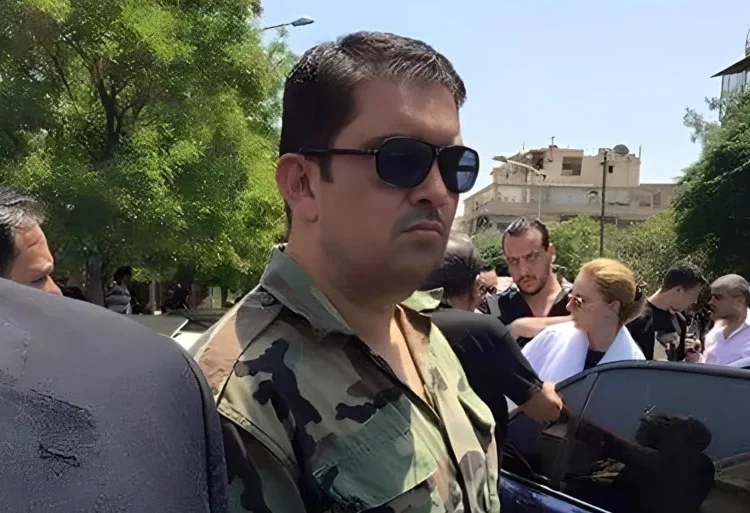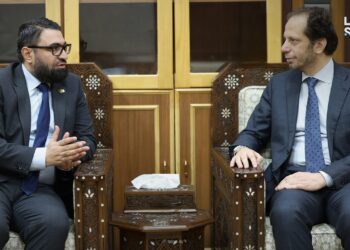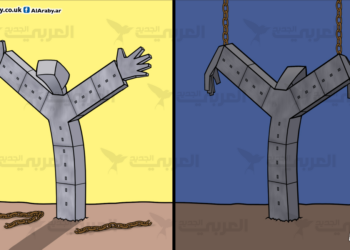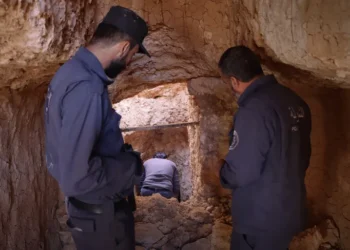Fadel Abdulghany
A few days ago, Fadi Saqr, a leader in the Assad regime’s National Defense Forces militia, appeared in a video recording in which he appeared as a mediator for the release of those implicated in committing violations. On February 4, 2025, Damascus witnessed a remarkable scene when Major General Mohammed al-Shaar, the former Syrian Minister of the Interior and architect of systematic repression, emerged from hiding to announce his voluntary surrender to the General Security Directorate.
He then appeared in a television interview in which he declared his innocence for any of the violations committed by the Assad regime. This media appearance represented a disturbing phenomenon in the context of the Syrian transition, as this brazen denial raised profound questions about impunity amid political transformations. What structures enable those responsible for crimes against humanity to negotiate their surrender rather than face immediate accountability?
Understanding Impunity and the Evolution of Command Responsibility
The concept of command responsibility is one of the most prominent contributions of international criminal law to combating impunity. This concept has evolved from a military to a civilian framework, forming the legal basis for holding ministers and senior officials accountable for systematic crimes.
The Rome Statute regulates this development, clarifying the differences between the responsibilities of military and civilian command, as Article 28(b) stipulates that civilian commanders shall be held responsible if they knew, or intentionally disregarded, information clearly indicating that their subordinates were committing crimes.
Although this standard appears more restrictive than that imposed on military leadership, it reflects the reality of information flow in civilian bureaucracies. The importance of the “conscious disregard” standard is particularly evident in ministerial positions, where officials can deliberately isolate themselves from the details of implementation while retaining control over public policy.
The concept of structural violence, as developed by Johan Galtung, provides a theoretical framework for understanding how impunity permeates state institutions. In contrast to direct violence, which is manifested in obvious acts of physical harm, structural violence operates through social structures that prevent individuals from meeting their basic needs.
When this concept is applied to security agencies, it becomes clear that impunity not only reflects the absence of justice, but is an effective system for perpetuating violence through bureaucratic mechanisms.
According to Galtung, security services produce what he calls “negative peace,” the absence of direct violence through systematic repression rather than by addressing the causes of conflict. This system is based on the expectation that state officials who commit violations will not be punished, creating a motivational environment that rewards brutality and punishes restraint.
This dynamic was clearly embodied during the slogan era, as officers who tortured or shot protesters were granted immunity, while those who showed leniency risked being accused of loyalty to the opposition.
The normalization of atrocities through bureaucratic practices is a central mechanism supporting structural violence. Official forms, administrative protocols, and operating procedures are transformed into tools for the implementation of murder, torture, and enforced disappearance, making them appear like routine administrative tasks.
Documented practices by the Syrian Ministry of Interior—such as registering the forcibly disappeared as dead, implementing property confiscations through civil courts, or imposing travel bans through passport offices—show how atrocities are remarketed through a bureaucratic administrative stamp, giving them a veneer of deceptive legitimacy.
Transitional Justice and Civil Peace – The Model of Fadi Saqr
The field of transitional justice emerged as an independent path following democratic transitions in Latin America and Eastern Europe, providing frameworks for dealing with the legacy of authoritarian regimes or armed conflict.
Theoretical tensions in this area are increasing: between civil peace and transitional justice, and between victim-centered and perpetrator-centered approaches.
The “peace versus justice” dilemma is at the heart of this debate. While scholars such as Jack Snyder and Leslie Vinjamuri argue that premature prosecutions can destabilize fragile transitions and reignite conflict, and advocate for a “peace first” approach that prioritizes stability before moving toward accountability, Kathryn Sikkink argues that delaying justice gives perpetrators the opportunity to destroy evidence, intimidate witnesses, and entrench impunity.
The “cascade of justice” theory suggests that early judicial accountability can have a deterrent effect and strengthen the rule of law. The Syrian context takes this dilemma to its extreme: Can real stability be achieved while figures like Fadi Saqr remain beyond accountability, or does this impunity itself undermine the chances of sustainable peace?
The contrast between victim-centered and perpetrator-centered approaches highlights an additional theoretical contradiction. Victim-centered transitional justice prioritizes truth-telling, acknowledgment, and reparation, as demonstrated by the work of truth commissions that offer amnesty in exchange for testimonies. This approach is based on the premise that victims seek acknowledgment and prevention of recurrence more than they seek revenge.
The perpetrator-centered approach focuses on criminal accountability as a means of achieving justice and preventing impunity. The limitations of the first approach are evident when dealing with senior officials. While soldiers can be recruited to participate in exchange for amnesty, figures like al-Shaar possess incriminating knowledge of the entire system, making their involvement unlikely unless they face serious pressure to prosecute.
The Legal Responsibility of Al-Shaar
The clearest indications of Mohammad Al-Shaar’s direct responsibility are evident in his membership in the “Crisis Cell,” established in March 2011 as the highest security decision-making body in Syria.
Testimonies from defectors and verified documents reveal that this cell held regular meetings to coordinate the security response to the protests, chaired personally by Bashar al-Assad. As Minister of Interior and an active member of this cell, al-Shaar contributed to formulating policies that clearly authorized the use of lethal force against demonstrators.
Minutes of the meetings obtained by the Syrian Network for Human Rights show explicit references to “decisive security solutions” and “eliminating terrorist groups”—both veiled euphemisms for orders to carry out massacres.
The presence of the slogan in these meetings, and their coincidence with the Interior Ministry’s subsequent implementation of mass killings, demonstrates a clear causal relationship between policy planning and the execution of crimes.
This temporal correlation between the Crisis Cell’s decisions and the escalation of violence by the Ministry of Interior reinforces this. Data from the Syrian Network for Human Rights shows a significant increase in civilian casualties following certain meetings, particularly those discussing the Friday demonstrations.
The coordinated geographic distribution of the killings across multiple governorates also points to systematic central planning, rather than random violence. Al-Shaar’s dual position as Minister of Interior and member of the Crisis Cell enabled him to transform security plans into direct executive orders.
Leaked documents from the Ministry of Interior in 2011 and 2012 include instructions signed by al-Shaar, or referencing his verbal orders, addressed to branches of Political Security, the Immigration and Passports Department, and the Civil Registry. These directives include setting “arrest quotas,” monitoring opposition supporters, and the execution of those forcibly disappeared.
These documents—through official letterheads, seals, and distribution lists—demonstrate the systematic, bureaucratic nature of policy implementation, not just individual or arbitrary orders. The seriousness of these documents is highlighted by the circulars authorizing “maximum pressure” on protesters and their families, an implicit reference to torture and collective punishment.
The Arming of the Ministry of Interior’s Functions
The transformation of the Syrian Ministry of Interior from a civilian administrative body into a tool for systematic repression is a stark example of the “arming of institutions.” Under Mohammed al-Shaar, between April 2011 and October 2018, the ministry shifted from performing its traditional functions to a comprehensive security role serving an authoritarian regime.
The integration of administrative and security functions under al-Shaar’s command represented a qualitative shift in Assad’s governance practices. While traditional authoritarian regimes maintain a symbolic separation between the secret police and civilian administrations, Assad’s Syria has achieved integration between the two.
The Immigration and Passports Department, theoretically tasked with issuing documents, has become a security apparatus that has arrested 1,608 civilians, including 73 who received official “security settlements,” according to documentation by the Syrian Network for Human Rights.
Civil registry offices, supposedly responsible for registering births and deaths, have also been implicated in falsifying records to conceal forcibly detained individuals. This fusion of administrative and security functions has undermined any sense of security within the state bureaucracy, making it difficult for citizens to distinguish between administrative procedures and security traps.
The scope of the Political Security Directorate, nominally responsible for monitoring political activities, expanded to include all government departments. The Criminal Security branches, traditionally concerned with ordinary crimes, were also granted new powers to investigate “terrorism,” a term often used to stigmatize any opposition activity.
Most seriously, information flows were reorganized so that all ministries were required to provide the Ministry of Interior with citizen data, creating a vast surveillance infrastructure that enables arrests based on administrative indications of perceived opposition sympathy.
The Syrian Network for Human Rights documented a total of 256,364 violations directly attributed to the Ministry of Interior’s agencies—a figure likely understated given the difficulties of documentation under authoritarian rule.
The 10,542 civilian deaths in the demonstrations reflect the adoption of shoot-to-kill policies, not a mere failure to control crowds. The geographical spread of these operations, which was not limited to opposition strongholds, points to central planning, not local deviations.
“Administrative persecution” represented an innovative contribution by the Ministry of Interior to the methodology of repression, employing institutionalized violence codified by legal instruments. Property confiscations, which totaled 11,267 cases, were carried out through sham judicial proceedings, transforming the courts into instruments of persecution.
Travel bans, which affected 115,836 people, enabled arrests at border crossings. 112,000 search warrants were issued, used to carry out systematic raids under the guise of law. This form of administrative violence has proven its sustainability and effectiveness, drawing limited international condemnation while contributing to tighter control over the population.
Al-Shaar as a Test Case for Syrian Transitional Justice
Al-Shaar’s emergence from hiding—claiming to “surrender” without any immediate arrest, then appearing in the media denying responsibility—reveals how perpetrators exploit the uncertainty and vacuum of the transitional period. Allowing him to surrender without immediate accountability sends a very dangerous message:
- First, it demonstrates that the perpetrator’s interests may have been prioritized over the rights of victims, as he chose the timing of his appearance, crafted his own narrative, and avoided the humiliation his victims faced during their forced detention. This behavior is completely inconsistent with the principles of transitional justice, which uphold the dignity of victims.
- Second, it suggests the possibility of negotiating with systematic perpetrators, whether through the exchange of information or assets in exchange for favorable treatment. Such precedents encourage a dangerous strategic behavior: perpetrators will only cooperate on their own terms. The Syrian authorities’ response to the al-Shaar and Fadi Saqr cases will set a precedent with far-reaching consequences for the transitional justice process. Balancing the imperatives of stability and the demands of accountability requires a careful analysis that goes beyond the “justice or peace” dichotomy. True stability cannot be achieved without accountability that establishes legitimacy.
The question now arises of timing and gradualism: Should the slogan be tried immediately based on documentary evidence, while investigations continue? And how can institutional knowledge be extracted from it without granting it immunity? These approaches require established institutions capable of accomplishing the task with skill.
Conclusion: The Price of Impunity
The impunity of senior officials undermines the moral foundations essential for consolidating civil peace and stability. Transitional justice studies demonstrate that societies emerging from contexts of systematic violence require a “narrative confession”—a collective agreement about what happened, who bears responsibility, and why it must not happen again.
When perpetrators of crimes, like the slogan, succeed in manipulating the public narrative and disavowing their roles through the media, they obstruct this necessary recognition. The resulting narrative vacuum is filled with denials and competing myths, undermining the chances of reconciliation and poisoning democratic debate.
Syria includes thousands of individuals implicated in violations across military, security, judicial, and administrative institutions, who are closely monitoring the progress of Al-Shaar’s case. A successful trial would demonstrate the transitional government’s resolve to break the cycle of impunity. Failure would send a message that political consensus can be used as a shield to protect against accountability, strengthening the perpetrators’ immunity and encouraging them to entrench and resist.
Breaking the cycle of impunity is a strategic imperative to ensure long-term stability. Societies that fail to hold accountable systematic crimes face a real potential for renewed violence.
Perpetrator networks, which still possess influence and resources, threaten the stability of the state and its nascent institutions. Victims, deprived of official recognition, tend toward alternative forms of justice, including revenge. This climate creates fragility that could lead to the return of authoritarianism or renewed conflict.
The issue of the slogan goes beyond individual accountability. As Minister of Interior during the bloodiest period in Syria’s modern history, he embodies institutionalized criminality. Confronting this legacy requires more than symbolic trials; it requires comprehensive approaches that address institutional culture, collective memory, and structural violence. This is what Syria needs—now, and urgently.






